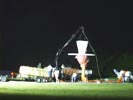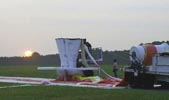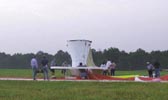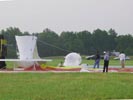|
|
On
July 18, 1998, after about a two month wait in Palestine,
Texas for the perfect weather conditions, we launched
the first test flight for the TopHat package. This
test flight includes a high fidelity mockup of the
payload on top of the balloon, and a simple payload
below. A simple data acquisition system gathered engineering
data to help understand the conditions during the
launch, and to check the thermal design of the top
package after it reached float altitudes.
The launch procedure uses two balloons. The smaller
"tow" balloon holds the package on top of
the "main" balloon while it is being inflated.
After the main balloon is inflated, it supports the
weight of the payload, and the tow balloon is released
(before launching the main balloon). |

|
|
At
3 am, the payload patiently awaits inside the high
bay. A truck picks up the payload and brings it
to the launch pad.
The conical section is a light shield that protects
the telescope from stray light from the Sun and
Earth. The wiring are for temperature sensors that
will monitor the temperature of this shield when
it reaches the float altitudes.
The disk of white material is a protective Ethafoam
ring designed to stabilize the payload during launch,
and to prevent the balloon material from rising
up and being damaged by the payload.
The balloon is attached to the bottom of the payload,
shown here inside the protective red plastic cover.
The rest of the balloon is still inside the crate
at the bottom of the image.
At
the pad, a crane carefully lifts the payload off
the balloon box. The balloon material is carefully
unwound from the box and laid out on the ground.
|


|
The
NSBF staff carefully lay out the payload in preparation
for launch operations.
The cylindrical device on the right is the spool
release mechanism. The main balloon is wound around
this spool before inflation. The spool holds the
balloon down until launch. At that time, we release
the spool latch and the cylinder pivots up, releasing
the balloon.
At this point, the spool is still very close to
the payload. As inflation proceeds, the spool
will slowly move in the direction of the laid
out
balloon material (to the left of the image) and
allow the balloon to get much bigger above it.
The
payload waits for sunrise after all the balloon
material is laid out and the launch equipment
is ready.
|


|
|
Final
preparations are made on the payload. Pyrotechnics
that are used to release the tow balloon are checked,
and the data acquisition system is started.
|

|
CONTINUED
or RETURN TO IMAGES
|
|
|